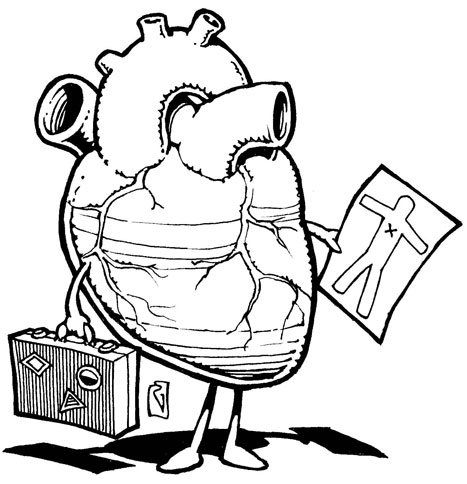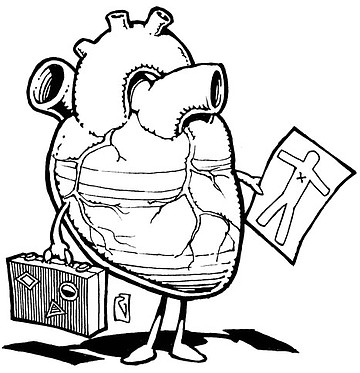 Facebook
Facebook
 X
X
 Instagram
Instagram
 TikTok
TikTok
 Youtube
Youtube

Mattster:
Say somebody has a liver transplant and then they die a while later in an accident. Can they take out the transplanted liver and give it to someone else? What would happen if somebody got a secondhand organ?
— Wayne S., El Cajon
Hey, great. We get to hunt down our staff quack, Dr. Doctor. Haven’t talked to him in a while. We had a little trouble finding him, but it turns out he was at a medical conference at a resort in Fiji. Something about ophthalmic problems from the use of too much glue on false eyelashes. Anyway, according to Dr. Doctor, there is a chance that the secondhand organ would work in a second recipient. It wouldn’t be everybody’s first choice, but in a pinch it might be re-transplanted. In fact, it has been done successfully with livers and kidneys.

But here are the ifs that might make the organ a little too shopworn to be used: If the organ has not been damaged too badly by lack of oxygen, it might be okay. When they whip out the organ the first time and put it in that iced-down picnic carrier, the lack of O2 starts degrading the tissues. So you’d have double the trouble with the second transplant. If there wasn’t too much surgical damage done to the tissues during the first transplant, it might be okay. There are specific surgical connections that have to be made in this operation, so if somehow the first surgeon was very careful, and the areas of connection weren’t too badly damaged, the second surgeon might be able to work with them. So these ifs, along with the problems of DNA matching, where the dead guy is located, where the recipient is, and how critical the re-transplant is make it pretty unlikely that a transplanted organ would be reused. A sparkly new, fresh liver would be the best choice.
Matt:
While planning a dinner out, somebody asked who was going to “foot the bill.” I made a quick dart to the men’s room to make sure it wouldn’t be me. But what does a foot have to do with a bill? You know. I’m sure you do.
— Out of Here, the men’s room
I’m sure I do too. In the 15th Century, a merchant engaged in footing was adding up a total, usually on a bill. By the 19th Century, “footing” also referred to paying the bill. So now we foot a bill, perhaps cleverly stepping on it so nobody can find it and we don’t have to pay it.
Hey, Matt:
For a while now, I’ve been using Breathe Right strips, those little spring-loaded adhesive strips that you see pro football players wearing, which hold your nostrils open like jet engine intakes. I’m using them to help control snoring, which they in fact do, allowing me to continue to sleep in the same bed as my wife and not in the garage with our dog. Often, I put the strip on my nose after I’ve turned out the light, which has led to an amazing discovery: As I am peeling open the sterile paper wrapper that the strips are packaged in, visible light sparkles are generated as the adhesive is pulled back. Where is this light coming from? If I press closed the wrapper and open it again, I get no light on the subsequent peeling. The light is not bright enough to see unless I’m in a darkened room. Also, if this is free light from nowhere, could we solve the world’s energy problems by peeling billions of Breathe Right in from of billions of solar cells?
— Mark, via email
If we can add Breathe Rights to our arsenal of free energy solutions, I guess we’d better add Wintergreen Life Savers. The trick works with them too. The elves spent days cramming themselves into Grandma’s closet, crunching on the candies and making blue-green sparks appear in their mouths. It absolutely cracked them up. Grandma finally booted them out, and eventually they lost interest.
What you’re seeing the science guys would call triboluminescence. Before you latch on to the Breathe Right package, all the adhesive molecules are hanging out, all in balance, snoozing soundly. But along comes you, ripping them apart and upsetting their tranquil evening. Electrons are flung off and they bash into nitrogen in the air and the aggravated nitrogen gives off a bluish light and you’re amazed. Same thing works with Band-Aid packaging and Wintergreen Life Savers. Get in a closet, put a candy in your mouth, and crunch down on it. You get the same fireworks, and the explanation is the same. Sleep tight.


Mattster:
Say somebody has a liver transplant and then they die a while later in an accident. Can they take out the transplanted liver and give it to someone else? What would happen if somebody got a secondhand organ?
— Wayne S., El Cajon
Hey, great. We get to hunt down our staff quack, Dr. Doctor. Haven’t talked to him in a while. We had a little trouble finding him, but it turns out he was at a medical conference at a resort in Fiji. Something about ophthalmic problems from the use of too much glue on false eyelashes. Anyway, according to Dr. Doctor, there is a chance that the secondhand organ would work in a second recipient. It wouldn’t be everybody’s first choice, but in a pinch it might be re-transplanted. In fact, it has been done successfully with livers and kidneys.

But here are the ifs that might make the organ a little too shopworn to be used: If the organ has not been damaged too badly by lack of oxygen, it might be okay. When they whip out the organ the first time and put it in that iced-down picnic carrier, the lack of O2 starts degrading the tissues. So you’d have double the trouble with the second transplant. If there wasn’t too much surgical damage done to the tissues during the first transplant, it might be okay. There are specific surgical connections that have to be made in this operation, so if somehow the first surgeon was very careful, and the areas of connection weren’t too badly damaged, the second surgeon might be able to work with them. So these ifs, along with the problems of DNA matching, where the dead guy is located, where the recipient is, and how critical the re-transplant is make it pretty unlikely that a transplanted organ would be reused. A sparkly new, fresh liver would be the best choice.
Matt:
While planning a dinner out, somebody asked who was going to “foot the bill.” I made a quick dart to the men’s room to make sure it wouldn’t be me. But what does a foot have to do with a bill? You know. I’m sure you do.
— Out of Here, the men’s room
I’m sure I do too. In the 15th Century, a merchant engaged in footing was adding up a total, usually on a bill. By the 19th Century, “footing” also referred to paying the bill. So now we foot a bill, perhaps cleverly stepping on it so nobody can find it and we don’t have to pay it.
Hey, Matt:
For a while now, I’ve been using Breathe Right strips, those little spring-loaded adhesive strips that you see pro football players wearing, which hold your nostrils open like jet engine intakes. I’m using them to help control snoring, which they in fact do, allowing me to continue to sleep in the same bed as my wife and not in the garage with our dog. Often, I put the strip on my nose after I’ve turned out the light, which has led to an amazing discovery: As I am peeling open the sterile paper wrapper that the strips are packaged in, visible light sparkles are generated as the adhesive is pulled back. Where is this light coming from? If I press closed the wrapper and open it again, I get no light on the subsequent peeling. The light is not bright enough to see unless I’m in a darkened room. Also, if this is free light from nowhere, could we solve the world’s energy problems by peeling billions of Breathe Right in from of billions of solar cells?
— Mark, via email
If we can add Breathe Rights to our arsenal of free energy solutions, I guess we’d better add Wintergreen Life Savers. The trick works with them too. The elves spent days cramming themselves into Grandma’s closet, crunching on the candies and making blue-green sparks appear in their mouths. It absolutely cracked them up. Grandma finally booted them out, and eventually they lost interest.
What you’re seeing the science guys would call triboluminescence. Before you latch on to the Breathe Right package, all the adhesive molecules are hanging out, all in balance, snoozing soundly. But along comes you, ripping them apart and upsetting their tranquil evening. Electrons are flung off and they bash into nitrogen in the air and the aggravated nitrogen gives off a bluish light and you’re amazed. Same thing works with Band-Aid packaging and Wintergreen Life Savers. Get in a closet, put a candy in your mouth, and crunch down on it. You get the same fireworks, and the explanation is the same. Sleep tight.
Comments